
Station Name: BROADWAY[Source:
Jo Roesen]
Broadway Station Gallery 1: 2nd Day - March 1960 old16.jpg) Broadway station on 2 August 1904, the day after opening. An excursion to Stratford was organised, in which no fewer than 623 people participated. They marched from Broadway town centre preceded by a band, and can be seen here lining up the station approach, waiting to buy tickets via the side gate. The train waiting at the platform was unable to take all of them and a number had to wait for the next service train. Behind the brake vehicle of the excursion train one of the navvies’ huts can be seen. In 1904, Broadway was a temporary terminus. The goods shed, just visible on the left, is under construction, and the signal box on the other side of the bridge is not yet there. A contractor’s train is just
visible beyond the bridge. Photo from GWSR (Broadway Area Group) collection  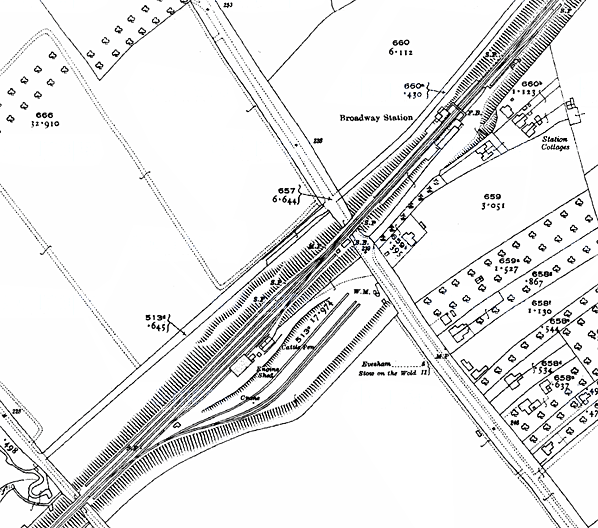
1923 1:2,500 OS map. The station is on the north-west side of Station Road with two facing platforms spanned by a footbridge. Immediately north of the down side a single siding serves a horse dock. The large goods yard is on the south-east side of Station Road with a weighbridge (WM) and office just inside the entrance to the yard. There is a single siding on the up side with five sidings on two levels on the down side. One siding runs alongside the goods shed (incorrectly identified as an engine shed) while another siding loops through it passing alongside the cattle dock and pens. Three parallel sidings at a lower level terminate close to the weighbridge. The 6-ton capacity yard crane is seen between these sidings. The coal yard was on the south side of the goods yard. The signal box is on the down side immediately south of the bridge. Click here for a larger version of this map.
old9.jpg) Broadway goods yard under construction. This yard is on made-up ground, with infill brought from Didbrook by train. On one occasion 10 wagons broke loose and ran down the slope, partly demolishing the weighbridge office. The station is already complete, with footbridge, in the background. The contractor's temporary line with FB rail bolted straight on to the sleepers is in the foreground on the right. The other tracks are GWR. The stationmaster's house and workers’ cottages are not yet in place. A man is working on the goods shed roof, and a horse-drawn wagon with flywheel, probably a stone crusher, is parked in front. There are no houses yet along the Evesham Road. Broadway goods yard under construction. This yard is on made-up ground, with infill brought from Didbrook by train. On one occasion 10 wagons broke loose and ran down the slope, partly demolishing the weighbridge office. The station is already complete, with footbridge, in the background. The contractor's temporary line with FB rail bolted straight on to the sleepers is in the foreground on the right. The other tracks are GWR. The stationmaster's house and workers’ cottages are not yet in place. A man is working on the goods shed roof, and a horse-drawn wagon with flywheel, probably a stone crusher, is parked in front. There are no houses yet along the Evesham Road.Photo from Broadway Caravan Club old1.jpg) Broadway station looking north. Note the early platforms, with wooden extensions, and a wagon standing at the horse dock beyond the platform. Station staff are seen on the left with some passengers on the right. This is a postcard dated November 1905 but the photograph could be a year earlier. The gents’ modesty screen on the right is still there; this was later replaced with a concrete shed. There are four platform lamps, one each side of each building, plus two suspended under the awning. There are no smoke trails under the footbridge, which suggests few trains so far.
Copyright photo from John Alsop collection
old3.jpg)
A Grange class with steam on hauls a train of hoppers towards Cheltenham. Although undated, the picture must have been taken between 1957, when the horse dock sidings were taken out, and 1959, when the crossover was also removed as in this picture it is still in place, to the left and a little behind the engine. There is interesting detail around the horse dock, an old sleeper-built shed buried in the embankment, next to the end of the dock. A line of GWR spearhead fencing ends in a cast iron GWR post, with a decorative ball on top. Unfortunately the original horse dock cannot be recreated, because the new platform will be extended northwards over the site, and also because the gardens of the stationmaster’s house have been extended, covering part of the dock.
Photo by John Diston old4.jpg) GWR 5421 trundles into Broadway station on a wet day in the 1950s. Two female passengers have stepped to one side to let the photographer get a good view of the incoming auto-train. The auto-coach, with its distinctive step handrails half way down the side, can just be made out behind. One lady is clutching a shopping bag, so perhaps a trip to Cheltenham is in the offing. 5421 was one of a small series of tank engines built by the GWR in the early 1930s for light passenger work, and all 25 examples were fitted with push-pull apparatus for auto-train operation. They were fast runners, but in the 1950s branch line work started to decline and the first withdrawal of the class was in 1956, with 5421 being withdrawn in 1962, when last based in Oswestry. None of the class has been preserved. In our collection is also a photograph of 5418 waiting at the station (author unknown). This loco
was withdrawn in 1960. Photo by John Diston old15.jpg)
A Castle with a long down 'Cornishman' is about to thunder through the station in the late 1950s. Note the pigeon baskets awaiting dispatch, the early style GWR benches, the lamp hut and two sack barrows parked under the bridge; the station is otherwise deserted.
Photo
by John Diston
old17.jpg)
A heavy freight train thunders through Broadway station, heading south c late 1950s. The loco is 9F 92224, a Crewe-built example which was scrapped in 1967 after a last allocation to 8B Warrington Dallam, following an initial allocation to Banbury. The train consists of mineral wagons and is typical of the type of freight that used the line between the Midlands and the South Wales coalfields. The headlamp code shows this to be an express freight train, one which would have shaken the station to its very foundations!
Photo by John Diston old2.jpg)
Broadway station in June 1959, nine months before the end of passenger services. Access to the horse dock beyond the buildings has been removed (1959), but the signals are still there. A trolley on the platform shows that the station is still open.
Copyright photo by RM Casserley old19.jpg) A typical ‘Coffeepot’ picture of Broadway, with 1424 about to continue in the Honeybourne direction with a single coach auto-train. There are no visible passengers. A schoolboy in macintosh and shorts is watching two members of staff in peaked caps go through some paperwork. The signal is ‘off’ and the sun is shining; only a few more days before passenger services ceased.
Photo from John Mann collection Click here for Broadway Station Gallery 2:
March 1962 - May 1969
|
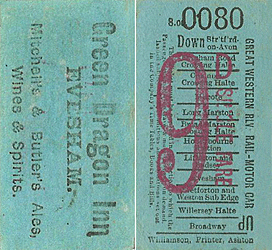 The line from Honeybourne to Cheltenham Malvern Road was built in sections between 1904 and 1906, the first section to Broadway opening on 1 August 1904. This was one of the last major lines built in England, with easy curves and modest gradients, and its long cuttings were excavated using steam shovels which very modern at the time. Many of the stations were built to a standard GWR design, where the station roof and platform canopy formed a single structure. A good example of this can be seen at Toddington; Broadway, too, had such a roof. The station was built of red brick, a surprising choice as Gotherington and Bishops Cleeve, further along the line, were built of Cotswold stone. Broadway village, about half a mile from the station, is a typical Cotswold village, which is popular with tourists. Although the village is built of honey-coloured Cotswold stone, the station did not emulate this. Another curiosity of the design was that the building did not have a front door; passengers entered by a side gate and reached the building via the platform to buy their tickets. This can be clearly seen in the 1904 picture, where a queue stretches all the way down the station approach road waiting to buy tickets via the side gate by the footbridge.
The line from Honeybourne to Cheltenham Malvern Road was built in sections between 1904 and 1906, the first section to Broadway opening on 1 August 1904. This was one of the last major lines built in England, with easy curves and modest gradients, and its long cuttings were excavated using steam shovels which very modern at the time. Many of the stations were built to a standard GWR design, where the station roof and platform canopy formed a single structure. A good example of this can be seen at Toddington; Broadway, too, had such a roof. The station was built of red brick, a surprising choice as Gotherington and Bishops Cleeve, further along the line, were built of Cotswold stone. Broadway village, about half a mile from the station, is a typical Cotswold village, which is popular with tourists. Although the village is built of honey-coloured Cotswold stone, the station did not emulate this. Another curiosity of the design was that the building did not have a front door; passengers entered by a side gate and reached the building via the platform to buy their tickets. This can be clearly seen in the 1904 picture, where a queue stretches all the way down the station approach road waiting to buy tickets via the side gate by the footbridge. 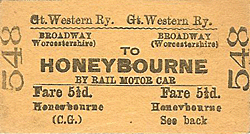 On platform 2 there was a second waiting room with gents’ toilet, again with the combination roof including the canopy. This was attached to the footbridge to give a dry passage all the way to the entrance gate. The footbridge was of a later design than those north of Stratford, with a straight deck and fewer embellishments than the earlier designs. These, for example at Stratford itself and at Wilmcote, had a stepped deck, cast iron supports and the date of manufacture embossed on the side. Broadway footbridge was plainer and, no doubt, cheaper to build.
On platform 2 there was a second waiting room with gents’ toilet, again with the combination roof including the canopy. This was attached to the footbridge to give a dry passage all the way to the entrance gate. The footbridge was of a later design than those north of Stratford, with a straight deck and fewer embellishments than the earlier designs. These, for example at Stratford itself and at Wilmcote, had a stepped deck, cast iron supports and the date of manufacture embossed on the side. Broadway footbridge was plainer and, no doubt, cheaper to build.
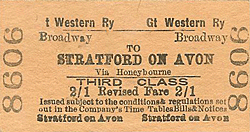 Freight traffic consisted principally of coal inwards - which was then distributed throughout the village by a coal merchant based in the goods yard - and agricultural produce outwards. The Vale of Evesham was intensively farmed for fruit and vegetables which would have been shipped via the railway. Cattle were sent to market, as well as milk which was dispatched in a Syphon van to Honeybourne in milk churns which were trolleyed on to platform 2 via the barrow crossing at the southern end of platform 1. The goods yard was on a slope, which caused wagons to run away on at least two occasions.
Freight traffic consisted principally of coal inwards - which was then distributed throughout the village by a coal merchant based in the goods yard - and agricultural produce outwards. The Vale of Evesham was intensively farmed for fruit and vegetables which would have been shipped via the railway. Cattle were sent to market, as well as milk which was dispatched in a Syphon van to Honeybourne in milk churns which were trolleyed on to platform 2 via the barrow crossing at the southern end of platform 1. The goods yard was on a slope, which caused wagons to run away on at least two occasions.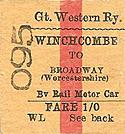 The employees that lived in the seven station houses formed quite a close-knit community. The children played ‘kick the can’ and football on the forecourt, undisturbed by cars. On one occasion, the local bobby joined in but kicked the ball against a station window and cracked it, after which he hurriedly made off. Roller-skating along the platform, down the ramp, across the rails and up the other side to platform 2 was also a favourite activity, regardless of the passing trains. With its single coach ‘Coffepot’ the only stopping train, Broadway was not a busy station. Passengers used it to come to work, to go to Cheltenham for shopping, or travel to school. Via Honeybourne, Oxford and London were in easy reach. However, from the 1950s, private cars began to lure the passenger traffic away, abetted by bus routes which better served some of the destinations such as Stratford.
The employees that lived in the seven station houses formed quite a close-knit community. The children played ‘kick the can’ and football on the forecourt, undisturbed by cars. On one occasion, the local bobby joined in but kicked the ball against a station window and cracked it, after which he hurriedly made off. Roller-skating along the platform, down the ramp, across the rails and up the other side to platform 2 was also a favourite activity, regardless of the passing trains. With its single coach ‘Coffepot’ the only stopping train, Broadway was not a busy station. Passengers used it to come to work, to go to Cheltenham for shopping, or travel to school. Via Honeybourne, Oxford and London were in easy reach. However, from the 1950s, private cars began to lure the passenger traffic away, abetted by bus routes which better served some of the destinations such as Stratford.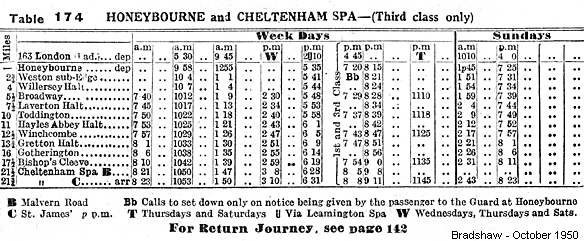
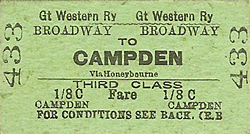 Thus Broadway station closed, even before Dr Beeching produced his infamous report. Once the buildings were taken out of use they became a liability for BR. The line was preferred for out-of-gauge loads, so in November 1963 the buildings were demolished and the platforms razed to track level. The main station building was dismantled, and some components ended up with nearby residents. Two sides of the signal box were used to create a lean-to in one of the station houses, the ceiling planks were sold by one of the gangers, and some of the platform paving slabs ended up in a nearby driveway. The footbridge went for scrap, while the waiting room on platform 2 was treated rather more brutally: it was demolished with a wrecking ball in the shape of a cartwheel, and then bulldozed into the cutting sides. Within two years the site of the station was a mere grass-covered shallow depression, with the tracks in the middle still in regular use by regular through traffic hauled by steam and, at the end, even by class 47s.
Thus Broadway station closed, even before Dr Beeching produced his infamous report. Once the buildings were taken out of use they became a liability for BR. The line was preferred for out-of-gauge loads, so in November 1963 the buildings were demolished and the platforms razed to track level. The main station building was dismantled, and some components ended up with nearby residents. Two sides of the signal box were used to create a lean-to in one of the station houses, the ceiling planks were sold by one of the gangers, and some of the platform paving slabs ended up in a nearby driveway. The footbridge went for scrap, while the waiting room on platform 2 was treated rather more brutally: it was demolished with a wrecking ball in the shape of a cartwheel, and then bulldozed into the cutting sides. Within two years the site of the station was a mere grass-covered shallow depression, with the tracks in the middle still in regular use by regular through traffic hauled by steam and, at the end, even by class 47s. 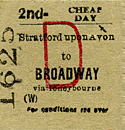 While BR hesitated over the future of the line, fate intervened. On 25 August 1976 a southbound freight train derailed on the infamous Chicken Curve just to the north of Winchcombe station. While the diesel loco stayed on the rails, the train itself derailed and wagons were scattered all over the ripped-up trackbed; it was never reinstated. Faced with considerable costs for a little-used line, BR threw in the towel and closed the line officially on 1 November 1976. The track was lifted in 1979.
While BR hesitated over the future of the line, fate intervened. On 25 August 1976 a southbound freight train derailed on the infamous Chicken Curve just to the north of Winchcombe station. While the diesel loco stayed on the rails, the train itself derailed and wagons were scattered all over the ripped-up trackbed; it was never reinstated. Faced with considerable costs for a little-used line, BR threw in the towel and closed the line officially on 1 November 1976. The track was lifted in 1979.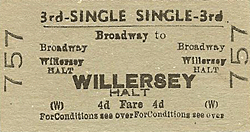 The intention is to rebuild Broadway station as a replica of its former self. A small number of changes will have to be accepted in order to meet modern requirements. The platforms will be longer, to accept 8-coach trains, and the main station building will be stretched to provide additional toilet facilities. The ticket hall will have doors on both sides so that passengers can enter the building from the station approach, instead of walking through the gates at the side and then down the platform. A footbridge, identical to the model that once stood at Broadway, has been sourced from Henley-in-Arden, further up the line. The platforms have been built from engineering blue bricks recovered from a demolished sewerage works at Wisley, a GWR wall at Taunton shed and the former MR turntable pit at Avonmouth, about 70,000 bricks in all. The main buildings will be constructed in new, imperial sized bricks of weathered reds, with the same architectural features as before. As the southern (goods) half of the site has been sold except for the main line, the new signal box will now be situated on platform two. The design will be similar to that at Shirley and will hold the former 45-lever frame from Aller Junction.
The intention is to rebuild Broadway station as a replica of its former self. A small number of changes will have to be accepted in order to meet modern requirements. The platforms will be longer, to accept 8-coach trains, and the main station building will be stretched to provide additional toilet facilities. The ticket hall will have doors on both sides so that passengers can enter the building from the station approach, instead of walking through the gates at the side and then down the platform. A footbridge, identical to the model that once stood at Broadway, has been sourced from Henley-in-Arden, further up the line. The platforms have been built from engineering blue bricks recovered from a demolished sewerage works at Wisley, a GWR wall at Taunton shed and the former MR turntable pit at Avonmouth, about 70,000 bricks in all. The main buildings will be constructed in new, imperial sized bricks of weathered reds, with the same architectural features as before. As the southern (goods) half of the site has been sold except for the main line, the new signal box will now be situated on platform two. The design will be similar to that at Shirley and will hold the former 45-lever frame from Aller Junction.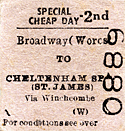 The total cost of returning trains to Broadway is estimated at £1.5m. This breaks down into three approximately equal parts: the cost of repairing the five underbridges along the two-mile missing stretch, the cost of the track replacement, and the cost of rebuilding the station and signal box. A share issue under an EIS has been launched for repairing the bridges, and further details can be found at
The total cost of returning trains to Broadway is estimated at £1.5m. This breaks down into three approximately equal parts: the cost of repairing the five underbridges along the two-mile missing stretch, the cost of the track replacement, and the cost of rebuilding the station and signal box. A share issue under an EIS has been launched for repairing the bridges, and further details can be found at old7.jpg)
old5.jpg)

 Home Page
Home Page